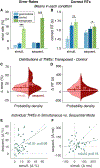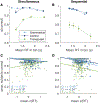The transposed word effect is consistent with serial word recognition and varies with reading speed
- PMID: 37331325
- PMCID: PMC10527089
- DOI: 10.1016/j.cognition.2023.105512
The transposed word effect is consistent with serial word recognition and varies with reading speed
Abstract
The scientific study of reading has long been animated by questions of parallel vs. serial processing. Do readers recognize words serially, adding each one sequentially to a representation of the sentence structure? One fascinating phenomenon to emerge from this research is the transposed word effect: when asked to judge whether sentences are grammatical, readers often fail to notice grammatical errors caused by transposing two words. This effect could be evidence that readers recognize multiple words in parallel. Here we provide converging evidence that the transposed word effect is also consistent with serial processing because it occurs robustly when the words in each sentence are presented serially. We further investigated how the effect relates to individual differences in reading speed, to gaze fixation patterns, and to differences in difficulty across sentences. In a pretest, we first measured the natural English reading rate of 37 participants, which varied widely. In a subsequent grammatical decision task, we presented grammatical and ungrammatical sentences in two modes: one with all words presented simultaneously, and the other with single words presented sequentially at each participant's natural rate. Unlike prior studies that used a fixed sequential presentation rate, we found that the magnitude of the transposed word effect was at least as strong in the sequential presentation mode as in the simultaneous mode, for both error rates and response times. Moreover, faster readers were more likely to miss transpositions of words presented sequentially. We argue that these data favor a "noisy channel" model of comprehension in which skilled readers rely on prior knowledge to rapidly infer the meaning of sentences, allowing for apparent errors in spatial or temporal order, even when the individual words are recognized one at a time.
Keywords: Parallel processing; Reading; Serial processing; Transposed word effect; Word recognition.
Copyright © 2023 Elsevier B.V. All rights reserved.
Conflict of interest statement
Declaration of Competing Interest None.
Figures





Similar articles
-
The transposed-word effect does not require parallel word processing: Failure to notice transpositions with serial presentation of words.Psychon Bull Rev. 2023 Feb;30(1):393-400. doi: 10.3758/s13423-022-02150-9. Epub 2022 Jul 26. Psychon Bull Rev. 2023. PMID: 35882721
-
The transposed-word effect provides no unequivocal evidence for parallel processing.Atten Percept Psychophys. 2023 Nov;85(8):2538-2546. doi: 10.3758/s13414-023-02721-5. Epub 2023 May 15. Atten Percept Psychophys. 2023. PMID: 37188860 Free PMC article.
-
Word order effects in sentence reading.Cogn Psychol. 2025 Mar;157:101715. doi: 10.1016/j.cogpsych.2025.101715. Epub 2025 Feb 16. Cogn Psychol. 2025. PMID: 39955834
-
Phonics training for English-speaking poor readers.Cochrane Database Syst Rev. 2018 Nov 14;11(11):CD009115. doi: 10.1002/14651858.CD009115.pub3. Cochrane Database Syst Rev. 2018. PMID: 30480759 Free PMC article.
-
Readers use word length information to determine word order.J Exp Psychol Hum Percept Perform. 2023 Jun;49(6):753-758. doi: 10.1037/xhp0001107. Epub 2023 May 11. J Exp Psychol Hum Percept Perform. 2023. PMID: 37166934 Review.
Cited by
-
The impact of relative word-length on effects of non-adjacent word transpositions.Psychon Bull Rev. 2025 Aug;32(4):1572-1578. doi: 10.3758/s13423-024-02637-7. Epub 2025 Jan 17. Psychon Bull Rev. 2025. PMID: 39825045
-
40 Years of Cracking the Orthographic Code: A Special Issue in Honour of Jonathan Grainger's Career.J Cogn. 2024 Dec 13;7(1):74. doi: 10.5334/joc.413. eCollection 2024. J Cogn. 2024. PMID: 39678174 Free PMC article.
-
Do Love You Me? Failure to Notice Word Transpositions is Induced by Parallel Word Processing.J Cogn. 2024 Jan 30;7(1):21. doi: 10.5334/joc.335. eCollection 2024. J Cogn. 2024. PMID: 38312941 Free PMC article.
-
Flexible word position coding in reading: Roles for attention and memory.Mem Cognit. 2025 Apr;53(3):974-982. doi: 10.3758/s13421-024-01623-7. Epub 2024 Aug 22. Mem Cognit. 2025. PMID: 39172204 Free PMC article.
-
The Spatiotemporal Dynamics of Bottom-Up and Top-Down Processing during At-a-Glance Reading.J Neurosci. 2024 Nov 27;44(48):e0374242024. doi: 10.1523/JNEUROSCI.0374-24.2024. J Neurosci. 2024. PMID: 39419549 Free PMC article.
References
Publication types
MeSH terms
Grants and funding
LinkOut - more resources
Full Text Sources

